Family : Monodontidae

Text © DrSc Giuliano Russini – Biologist Zoologist

English translation by Mario Beltramini
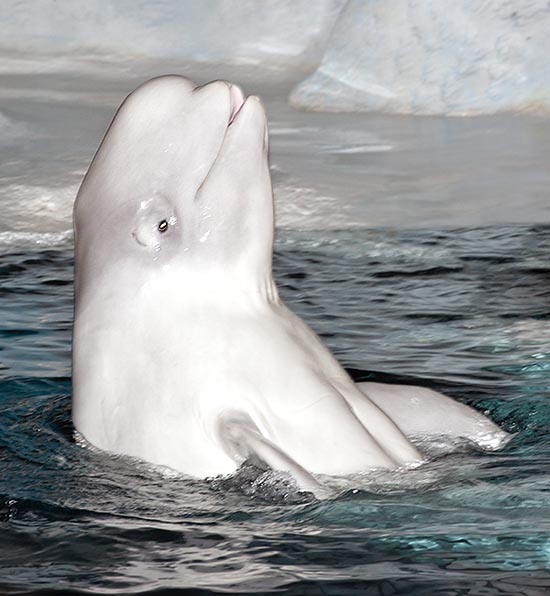
The Beluga (Delphinapterus leucas) belongs to the Cetaceans order © Giuseppe Mazza
The Beluga (Delphinapterus leucas Pallas, 1776) is a marine eutherian mammal afferent to the order of the Cetaceans (Cetacea), to the suborder of the Odontocetes (Odontoceta), to the family of Monodontids (Monodontidae) and to the genus Delphinapterus.
Zoogeography
It is a coastal species living in the Arctic Circle. It is found in the waters washing the shores of northern Canada, of Greenland, of Norway, of Russia, of Siberia and of Alaska.
Ecology-Habitat
The belugas frequent the cold and temperate waters of the boreal hemisphere, up to, rightly, the Arctic Circle.
Their presence in the Arctic waters is regulated by the extension of the ice. During the boreal winter, the northern limit coincides with the southern limit of the polar icepack; during the summer, this species migrates towards the coasts in zones which are well defined and known to the zoological biologists.
These very nice, sociable and cute aquatic mammals, adore indulging in the pleasure to rub the body against the rounded stones in the bottom of the rivers mouths and bask in the sun, practices that sometimes have proved dangerous. In 1966, in fact, an astray beluga remained trapped in the Rhine basin in the North Sea, going then upriver up to Bonn, before reversing direction and turning back in the sea at Rotterdam.
Taking advantage of their very nature, in the Saint Lawrence estuary, there was a fishing plant, where they were seized like fishes, in a sort of huge dam, nowadays luckily closed.
The tendency they have to enter the estuaries is due also by the seasonal cleaning of the skin, which must renew, and by the necessity to stop each year in shallow waters for giving birth to calves. At times, they are surprised by the arrival of the low tide, and some individuals get stranded. Trapped and immobile, they have then to wait for the return of the water, hoping that there are no predators, like a polar bear, in the area.
Still today, the belugas are killed by the Eskimos, who, like any other native population, tend to hunt in harmony with the nature, not blinded by the greed of the industrial and commercial fishing.
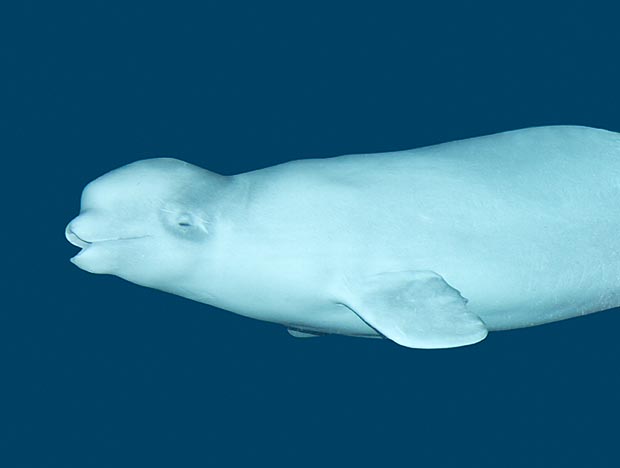
The frontal area is mobile and much developed for a perfect sonar operation © Giuseppe Mazza
They pick up only what is strictly needed, by using all what this delphinapterus can furnish: flesh, fat, skin, bones and teeth, but they have anyway a strong impact on the species.
The catches represent from the 2-24% of each single stock, reaching the highest values along the Canadian coasts, with more than 3.000 animals per year.
Morpho-physiology
The scientific name of Delphinapterus leucas, comes from the fusion of “delphinos” = dolphin, with “a” = without, “pteron” = fin, “leucas” = white.
In Italian and Spanish it is called beluga, in French bélouga and in English white whale or, again, beluga.
Indeed, if compared to a dolphin or an orca, this cetacean lacks of the dorsal fin, which is only slightly outlined. The females measure 4,1 m, the males 5,5 m, with a maximum weight of 1,6 t.
The fairly noticeable difference in length is a character of sexual dimorphism. In nature they can reach an age of 30-35 years. This splendid cetacean with the smooth skin, candid white, has a very marked frontal area of the skull, which it is able, with its muscles, to move, in relation to the focus or the direction of the sonar emission.
It has quite robust and strong pectoral fins, shorter than those of the Tursiops dolphin, or Bottlenose dolphin (Tursiops truncatus), but wider and more robust.
It has a sort of beak under the protuberance of the front. A slight narrowing can be seen behind the head, which might remind a neck, and the fat layer covering it is tenderer than that of other cetaceans.
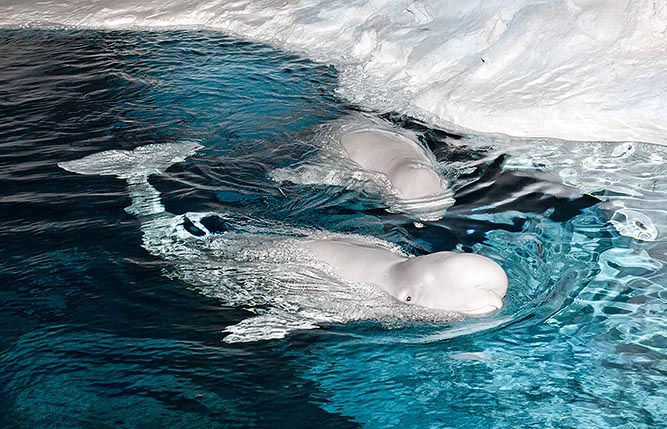
Lives along the Arctic icepack and the tail, unlike fishes, develops horizontally © Giuseppe Mazza
The tail is powerful and tends to taper towards the rear apex less than that of other odontocetes.
The caudal fin, forked, is in horizontal position, like all cetaceans, unlike the vertical-sagittal position present in the fishes.
The eyes, lateral, are small in comparison of the skull; the conical teeth are none, per each side of the mouth.
The stomach of the cetaceans is subdivided in chambers like that of the ruminants, to whom, anyway, they are strictly akin.
The cetaceans, and therefore also the beluga, breathe surfacing with the dorsal extremity of the skull, where the nostrils have melted to form the blowhole or spiracle; like in all mammals, the lungs are two and are lobed. The respiratory frequency is lower than that of the terrestrial mammals, each breath lasts only 0,3 seconds, and they can change the 80% of the air they have inhaled. The beluga is able to remain in apnoea, while diving, for about 15 minutes, reaching even 647 m of depth; the maximum speed it can achieve is of 20 km/h.
The diet of the beluga is a typical example of adaptation to the productivity of the Arctic seas and varies greatly, even if it prefers the benthonic species of fishes, molluscs and other marine invertebrates, which it shares with other predators, among which the Narwhal (Monodon monoceros) and some species of seals. Unfortunately, the human being, as rightly the French biologist René Dubos declared during the seventies of the last century, at the Third World Congress of Ecology, is “the most dangerous agent of out Planet”; as a matter of fact, the pollution of the seas with every sort of noxious substances or not degradable agents, above all the plastic, is the cause of numerous killings of marine mammals, not to forget birds, fishes and reptilians.
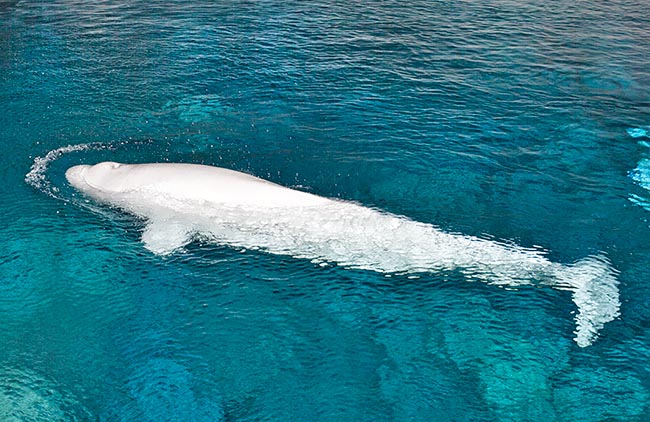
Males may be 5,5 m long. No dorsal fin, just outlined © Giuseppe Mazza
Substances used in agriculture, such as the polychlorinated ones, commonly known as pesticides (for instance, the PCBs, the DDTs, the DDEs, etc.) reach, through the rivers, the marine waters, and to this we have to add the oil spilled by leaks in the plants or sunken vessels.
This causes in the cetaceans hepatic cirrhoses, tumours, pulmonary infections and sterility in the males as well as in the females; or, by weakening their immune system causes their death for beaching, due to viral infections to which they cannot react any more, as is the case of the morbillivirus.
The plastic bags that soil our seas are a danger for all the cetaceans, beluga included, and in particular of those species eating cephalopods, that is, teutophagous.
These bags, in fact, may be mistaken for such marine invertebrates and therefore may be swallowed causing the obstruction of the alimentary duct. The animal feels always sated and does not eat anymore, thus dying wretchedly of starvation and of organic deficiency.
Also the “drift nets” extending for miles, utilized in the trawling cause accidental deaths in the cetaceans.
The beluga is an animal with lively intelligence as well as all cetaceans, they are often present in the aquatic parks and in the zoological gardens, for instance in USA, in Florida, Louisiana, etc., where they adapt very well reproducing and interact very affectionately with the human being, a real treat for the kids; I must admit a certain weakness for this sweet animal, as well as for the Long-finned pilot whale (Globicephala melas).
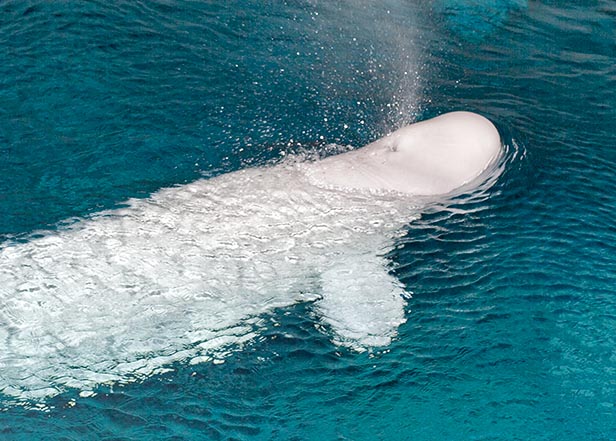
Each breath lasts 0,3 seconds only, with change of 80% of inhaled air © Giuseppe Mazza
Although the intelligence characterizing the various species of dolphins and cetaceans s undoubtedly high (higher than that of a dog), as the ethologists have proved, on the zoological point of view, however, lacking a series of anatomical, and therefore also sensorial correlates, which are present, on the contrary, in the great apes such as the Chimpanzee (Pan troglodytes), render still now the anthropomorphic apes the most intelligent animals along the zoological scale, after the Homo sapiens; these correlates are, for instance, the hand, the opposable thumb and other structures.
The theories in this field are the most varied, but they go out of my education as field zoologist; probably, the intelligence needs interpretations which are more appropriate to other types of biologists, such as the ethologists, the neurobiologists or other professionals like the philosophers and the psychologists.
Also in the beluga, as well as in all the Cetacea, the adaptation in an environments like the aquatic one, where the visibility is remarkably reduced in the best of cases to only few tens of metres, has led to the development of a sophisticated system of production and reception of the sounds, which identifies in the “echolocation”.
Like other marine organisms (invertebrates, fishes, reptilians, pinnipeds), also the cetaceans are capable to produce a great variety of sounds useful for communicating each other, by means of the creation of a real and proper language, species-specific, thus getting information about the environment surrounding them, useful for navigating, for finding food, for reproducing or for escaping a predator.
These sounds may have high frequencies not perceivable to the human hearing, that is, like ultrasounds, or perceivable frequencies. This system of “acoustic vision” is present in the odontocetes as well as in the mysticetes. The sounds emitted for the echolocation usually have very high frequencies, over the 200.000 cycles per second. The penetration of the sounds emitted is inversely proportional to their length; therefore the cetaceans modulate it as is the case.
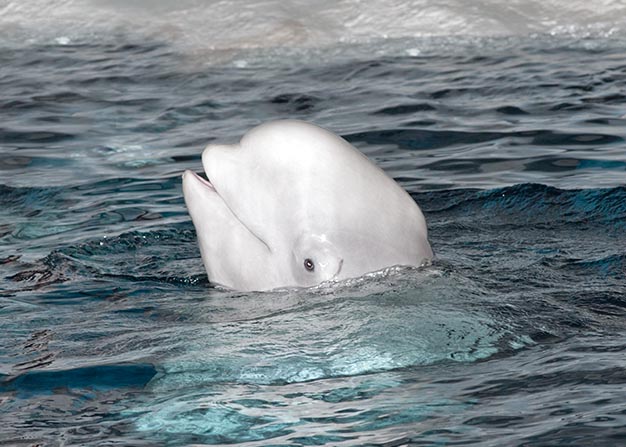
The beluga emits also audible sounds, like twitters, whence the name
During the normal swimming conditions, they emit low frequency sounds which have a radius of action of some tens of kilometres.
The emission frequency is varied once the return echo carries with itself the information of something interesting which has been localized. An adipose structure, known under the name of “melon”, placed in the frontal lobe of the cetacean, is thought to have the role of acoustic lens, which should concentrate the signals of the “sonar” produced and received by the animal. Besides this sonar system, based on ultrasounds, the odontocetes emit, as mentioned, a series of audible sounds for communicating each other. Usually, these sound, that the human being can perceive, for instance on the bridge of a vessel, are covered by the noise of the wind and of the waves, if the animal is close, then can be heard; such sound is a so much typical musical trill that the beluga was called by the ancient whale hunters “sea canary”.
Ethology-Reproductive Biology
The vital cycle of the beluga is marked by the seasonal migrations it does along the coasts of the Arctic seas. The movements are regular, even if they do not cover long distances and take place in conjunction of several factors: the formation of the ices, the different distribution of the food and the weaning of the calves. Even if it has been proved that the beluga may go down beyond the 600 of depth, this species shows a particular preference for the shallow waters, and is capable to swim where the water is so low that its body is only partially covered by the same.
This measure allow the animal to get some advantages: the skin, rightly exposed to the sun, permits the animal a lesser waste of energy for regulating the temperature, the low water facilitates its escaping the predators, such as the orca, and finally, inside the estuaries, where seasonally some preys abound, it can find sufficient food.
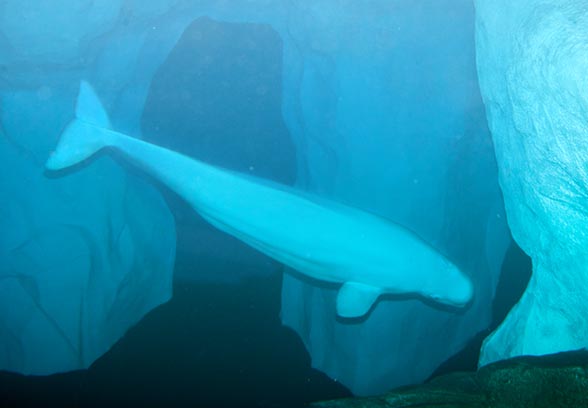
Even if loving estuaries and low waters, the beluga may reach the 600 m of depth © Giuseppe Mazza
The belugas move in group and the subgroups are formed bye females with calves, separate from the mature males. During the summer migration, the senior individuals lead the way and enter the first into the estuaries, whilst the remainder of the group keeps offshore. The pregnant female has a gestation period lasting from 11 to 14 months. Only one calf is born at the time, and it measures 1,6 m with a weight of 79 kg. The calf gets off with the tail first, then, once outside, the mother or a companion assisting her during the delivery, will take it immediately to the surface for breathing.
At the birth the calves are spotted and dark, then get paler, during the growth, by the fifth year of age, and finally become totally white.
The nursing period is of 20-24 months, the reproductive season is in spring-summer; the sexual maturity takes place between the 6 and the 10 years.
For this cetacean, the IUCN declares a status of “near threatened”.
